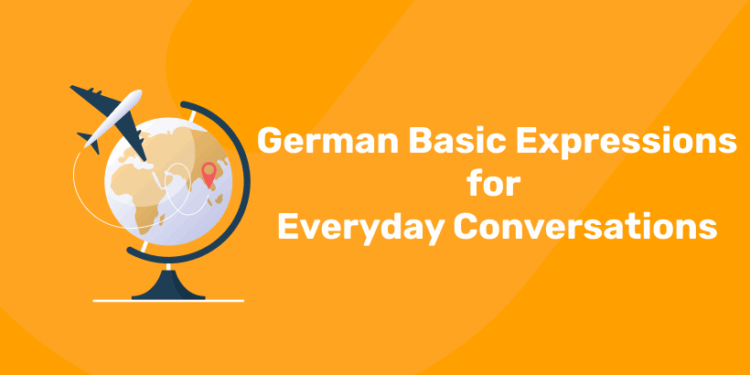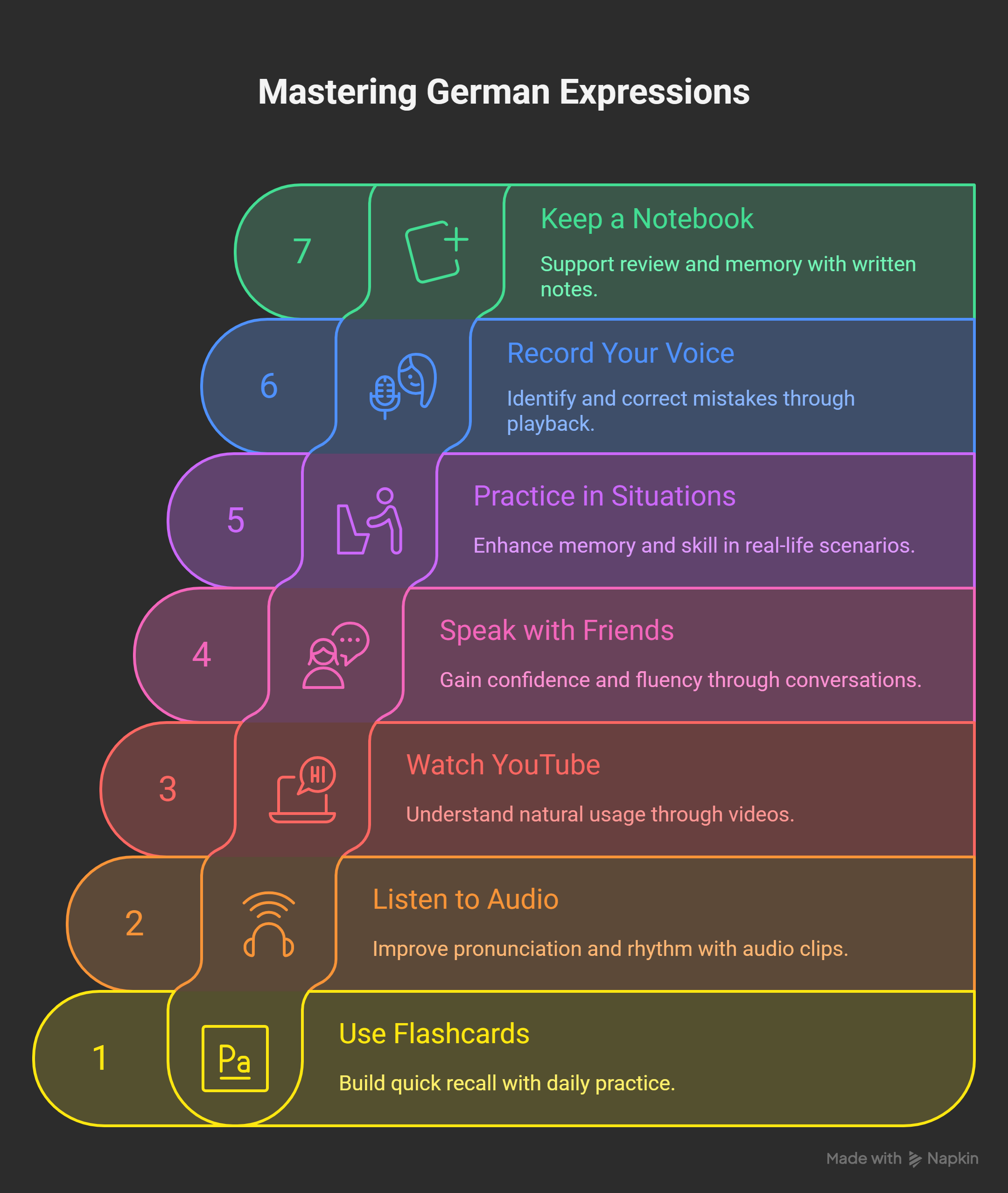Table of Contents
German Basic Expressions help beginners speak with confidence. These phrases support simple daily conversations. You can use them anywhere easily. They make communication smooth for learners. This blog explains many helpful expressions. You learn greetings and polite phrases. You also learn travel and shopping lines.
These sections guide you through daily situations. You see expressions for emotions and reactions. You learn idioms for natural speaking. Travel questions will be asked with ease. You handle shops and restaurants comfortably. You follow tips for daily practice. German speaking skills are built.
What This Blog Covers
- Simple greetings used in daily talk
- Polite and essential expressions
- Common expressions for home and work
- Travel and direction questions
- Shopping and restaurant phrases
- Emotional and social expressions
- Useful idiomatic expressions
- Easy practice tips for beginners
Start learning German today to fast-track your career in Germany!
Introduction
Learning German expressions helps beginners start conversations smoothly. These phrases give you quick speaking confidence. You understand daily interactions more easily. You respond faster in simple situations. Each expression supports natural communication habits. This blog explains them in a clear structure. You learn them through short, simple sections.
These expressions also build stronger listening skills. Recognizing common patterns becomes easier with practice. Conversations feel clearer with familiar expressions. Calm reactions come naturally in daily interactions. Communication improves when speaking with German speakers. Overall comfort grows in real situations. These phrases support steady language growth.
What You Will Learn
- Why simple expressions improve early communication
- How expressions support beginner confidence
- How short phrases strengthen listening skills
- Ways expressions improve daily understanding
- How expressions help in real conversations
- Steps to learn phrases effectively
- How to build steady expression habits
- How expressions support long-term language progress
Why Learning German Expressions Helps Beginners
1: How do you say "Good Morning" in German?
Learning basic expressions supports fast communication growth. Short phrases help beginners speak early. These expressions remove fear of mistakes. They guide learners through simple conversations. Each phrase builds steady speaking confidence. Daily usage becomes easier for new learners. These expressions also support clearer understanding.
Using expressions helps learners avoid complex grammar. Short lines feel easy to remember. Natural speaking becomes manageable for beginners. These expressions also improve quick responses. They help you understand common tones. These expressions supports real communication comfort. They create smoother learning experiences.
1. Expressions Build Early Confidence
- Short expressions reduce beginner stress.
- Simple words deliver clear communication.
- Daily use strengthens speaking comfort.
Key Benefits
- Easy to say
- Fast to remember
- Useful everywhere
2. Expressions Support Real Communication
- Real conversations need simple lines.
- Expressions help start quick interactions.
- Beginners respond without long pauses.
Examples
- Simple greetings help conversations.
- Polite phrases support respect.
- Short questions improve clarity.
3. Expressions Strengthen Listening Skills
- Hearing common expressions builds understanding.
- Patterns become easier to follow.
- Conversations feel less confusing.
Helpful Listening Points
- Notice repeated phrases
- Catch simple tones
- Understand basic replies
4. Expressions Guide Daily Tasks
- Daily tasks need quick words.
- Short phrases help in common situations.
- Beginners handle tasks more confidently.
Daily Use Examples
- Meeting people
- Asking help
- Buying items
5. Expressions Reduce Grammar Pressure
- Grammar feels difficult for starters.
- Expressions make communication simpler.
- Beginners speak more with fewer rules.
Why It Helps
- Less stress
- Faster speaking
- Clear communication
Useful Expression Types
The table below shows expression types and their uses.
| Expression Type | Main Use | Example Purpose |
|---|---|---|
| Greetings | Start conversations | Meet people easily |
| Polite Phrases | Show respect | Thank or request |
| Daily Lines | Manage tasks | Simple communication |
| Travel Phrases | Ask directions | Move confidently |
| Idioms | Natural speech | Break the ice |
Key Points
- Expressions support fast speaking growth
- Short lines improve communication comfort
- Daily practice strengthens memory
- Simple phrases guide real situations
- Expressions help beginners speak confidently
|
German A2 Exercises – Download Free PDF |
||
Speak German Fluently – Your Future Starts Here!
Join our interactive German courses designed for all levels. Gain the skills to communicate effectively and open doors to new cultures and careers.
Start Learning GermanHow They’re Used in Daily Life
German expressions appear in many daily moments. Short phrases support quick interactions. They help beginners manage simple tasks. These expressions guide real communication needs. Daily routines become easier with familiar lines. Learners understand situations more clearly. These phrases create smooth daily experiences.
Using expressions helps in public places. Short lines work in many settings. They support greetings, questions, and replies. Expressions help learners sound natural. They reduce confusion during conversations. They also build steady speaking habits. Daily life feels less stressful with them.
1. Expressions in Home Settings
- Home conversations need simple phrases.
- Short lines help share basic needs.
- Family interactions feel clearer.
Examples
- “Ich komme.”
- “Warte kurz.”
- “Ich brauche Hilfe.”
2. Expressions in School or Study Areas
- Students use expressions often.
- Short questions help understanding.
- Classroom tasks become easier.
Helpful Study Phrases
- Clarify instructions
- Ask doubts
- Request support
3. Expressions in Work Environments
- Work settings need polite lines.
- Short expressions support teamwork.
- Daily tasks feel more organized.
Workplace Uses
- Quick greetings
- Small requests
- Basic updates
4. Expressions in Public Places
- Public interactions need simple words.
- These lines guide polite behaviour.
- Common actions feel easier.
Public Situations
- Asking help
- Getting information
- Showing thanks
5. Expressions During Travel
- Travel needs clear questions.
- Short lines guide directions well.
- Tourists feel more confident.
Useful Travel Purposes
- Find locations
- Ask distances
- Seek transport help
Common Daily Expression Situations
The table shows where expressions help most.
| Situation | Main Use | Example Purpose |
|---|---|---|
| Home | Share needs | Simple communication |
| School | Understand tasks | Ask questions |
| Work | Stay polite | Quick updates |
| Public | Interact respectfully | Request help |
| Travel | Find places | Ask directions |
Key Points
- Expressions support daily communication
- Short lines fit many settings
- Daily use strengthens comfort
- Expressions reduce confusion
- Beginners manage tasks easily
Basic German Greetings and Introductions
Greetings create friendly beginnings in German conversations. Short phrases help start interactions smoothly. These expressions let beginners speak quickly. They support natural communication everywhere. Introductions also feel easier with simple lines. Each phrase helps build early confidence. Daily conversations become more comfortable.
Greetings appear in both formal and casual moments. Simple introductions fit many situations. These lines share basic personal details. They create polite communication habits. Learners use them without stress. They improve interaction flow. They guide clear first impressions.
1. Core German Greetings
- Core greetings work in most encounters.
- They sound polite and simple.
- Beginners use them confidently.
Examples with Meanings
- “Hallo” – Hello
- “Guten Morgen” – Good morning
- “Guten Abend” – Good evening
2. Friendly Casual Greetings
- Casual greetings feel relaxed and warm.
- Friends use these simple lines.
- They suit easy conversations.
Examples with Meanings
- “Hi” – Hi
- “Na?” – What’s up?
- “Hey” – Hey
3. Asking About Well-Being
- These questions show friendly care.
- They support short conversations.
- Beginners speak them comfortably.
Examples with Meanings
- “Wie geht’s?” – How are you?
- “Alles gut?” – Everything okay?
- “Wie läuft’s?” – How’s it going?
4. Introducing Yourself Simply
- Simple introductions share quick details.
- These lines help first meetings.
- They guide clear communication.
Introduction Steps
- Say your name
- Share your origin
- Offer a polite greeting
Examples with Meanings
- “Ich heiße…” – My name is…
- “Ich komme aus…” – I come from…
- “Ich bin neu hier.” – I am new here.
5. Replying to Introductions
- Replies help continue conversations.
- Short words keep things smooth.
- They create friendly connections.
Examples with Meanings
- “Freut mich.” – Nice to meet you.
- “Sehr angenehm.” – Very pleased.
- “Schön dich zu sehen.” – Nice to see you.
Greeting and Introduction Reference Table
| German Expression | English Meaning | Best Use |
|---|---|---|
| Hallo | Hello | General greeting |
| Guten Morgen | Good morning | Early hours |
| Wie geht’s? | How are you? | Friendly talk |
| Ich heiße… | My name is… | Introductions |
| Freut mich | Nice to meet you | First meetings |
Key Points to Remember
- Greetings start conversations smoothly
- Simple lines help beginners speak
- Introductions share basic details
- Friendly replies build comfort
- Daily use strengthens memory
|
Goethe 2025 Exam Dates: Multiple Test Centers |
|
| Trivandrum Goethe Exam Dates | Kochi Goethe Exam Dates |
| Chennai Goethe Exam Dates | Coimbatore Goethe Exam Dates |
Polite & Essential Expressions
Polite expressions support smooth communication in German. These lines show respect everywhere. Beginners use them in daily interactions. They help create friendly impressions. Simple phrases guide good behaviour. They make conversations feel lighter. They help avoid misunderstandings.
Essential expressions appear in many daily moments. They support quick responses. Short lines express needs clearly. They help during confusion or mistakes. These expressions keep conversations calm. They improve communication quality. They build strong speaking habits.
1. Basic Polite Words
- Polite words show good manners.
- They work in every situation.
- Beginners use them easily.
Examples with Meanings
- “Danke” – Thank you
- “Bitte” – Please / You’re welcome
- “Entschuldigung” – Sorry / Excuse me
2. Expressions for Small Requests
- These phrases help ask things politely.
- They keep requests gentle.
- They sound friendly and respectful.
Examples with Meanings
- “Können Sie helfen?” – Can you help?
- “Einen Moment, bitte.” – One moment, please.
- “Ich brauche das.” – I need this.
3. Expressions to Show Understanding
- These lines help show agreement.
- They keep conversations smooth.
- They help avoid confusion.
Examples with Meanings
- “Alles klar.” – All clear.
- “Verstanden.” – Understood.
- “Das passt.” – That works.
4. Expressions for Apologies
- Apologies help fix small issues.
- They show respect and care.
- They calm tense situations.
Examples with Meanings
- “Sorry.” – Sorry
- “Tut mir leid.” – I am sorry.
- “War keine Absicht.” – Not intentional.
5. Expressions for Quick Clarification
- These lines help clear doubts.
- They guide simple communication.
- Beginners use them often.
Examples with Meanings
- “Wie bitte?” – Pardon?
- “Noch einmal, bitte.” – Once again, please.
- “Langsam, bitte.” – Slowly, please.
Polite Expression Reference Table
| German Expression | English Meaning | Best Use |
|---|---|---|
| Danke | Thank you | Show gratitude |
| Bitte | Please / You’re welcome | Polite requests |
| Entschuldigung | Sorry / Excuse me | Mistakes or passing |
| Alles klar | All clear | Understanding |
| Wie bitte? | Pardon? | Clarification |
Key Points to Remember
- Polite words improve communication
- Short lines show respect everywhere
- Requests sound friendly with simple phrases
- Apologies calm difficult moments
- Clarification phrases prevent confusion
Start learning German today to fast-track your career in Germany!
Speak German Fluently – Your Future Starts Here!
Join our interactive German courses designed for all levels. Gain the skills to communicate effectively and open doors to new cultures and careers.
Start Learning GermanCommon Everyday Expressions
Everyday expressions help in regular situations. These lines support simple communication. They appear in many environments. Beginners use them constantly. They help express daily needs. They make routines feel easier. These phrases improve speaking comfort.
These expressions work at home or outside. They guide small tasks smoothly. Short lines help express quick actions. They support clear communication everywhere. Learners remember them easily. They fit many daily moments. They create steady speaking habits.
1. Expressions for Home Use
- Home tasks need simple phrases.
- They help share quick needs.
- Family communication becomes easier.
Examples with Meanings
- “Ich komme.” – I am coming.
- “Warte kurz.” – Wait a moment.
- “Ich bin fertig.” – I am done.
2. Expressions for School or Study
- Study situations need clear lines.
- These phrases help learning moments.
- Students use them daily.
Examples with Meanings
- “Ich verstehe.” – I understand.
- “Ich weiß nicht.” – I don’t know.
- “Kannst du helfen?” – Can you help?
3. Expressions for Office or Work
- Workplaces need simple communication.
- These lines support quick teamwork.
- They help share updates easily.
Examples with Meanings
- “Ich bin da.” – I am here.
- “Ich melde mich.” – I will update.
- “Kein Problem.” – No problem.
4. Expressions for Public Areas
- Public places need short phrases.
- They help manage simple interactions.
- Beginners use them confidently.
Examples with Meanings
- “Einen Moment.” – One moment.
- “Geht klar.” – Alright.
- “Ich verstehe nicht.” – I don’t understand.
5. Expressions for Quick Daily Actions
- These lines support small tasks.
- They work in many settings.
- They help communicate quickly.
Examples with Meanings
- “Warte mal.” – Wait a bit.
- “Komm mit.” – Come with me.
- “Alles gut.” – All good.
Everyday Expression Reference Table
| German Expression | English Meaning | Best Use |
|---|---|---|
| Ich komme | I am coming | Home tasks |
| Ich verstehe | I understand | Study moments |
| Kein Problem | No problem | Work replies |
| Geht klar | Alright | Public situations |
| Komm mit | Come with me | Quick actions |
Key Points to Remember
- Daily phrases appear everywhere
- Short lines support quick tasks
- Expressions help home communication
- Study phrases guide learning moments
- Public lines ease simple interactions
Expressions for Travel & Directions
Travel expressions help beginners move confidently. These lines support basic navigation. They appear in many travel moments. Short phrases guide simple questions. They work in cities or small towns. Learners use them often. These expressions make movement easier.
These phrases help ask clear questions. They support calm interactions with locals. Each line improves travel confidence. Beginners remember them quickly. They suit different travel situations. These expressions reduce confusion. They help guide every step.
1. Asking for Directions
- Travelers often need location help.
- These phrases guide basic direction requests.
- They work in many places.
Examples with meanings:
- “Wo ist das?” – Where is that?
- “Wo geht’s lang?” – Which way is it?
- “Wie komme ich dahin?” – How do I get there?
2. Transportation Queries
- Transport areas need clear communication.
- These lines support travel planning.
- They help understand schedules.
Examples with meanings:
- “Wo ist der Bahnhof?” – Where is the train station?
- “Wann fährt der Bus?” – When does the bus leave?
- “Ist das weit?” – Is it far?
3. Navigating Streets
- Street movement needs simple phrases.
- These lines guide walking directions.
- They help avoid confusion.
Examples with meanings:
- “Geradeaus, bitte.” – Straight ahead, please.
- “Nach links.” – To the left.
- “Nach rechts.” – To the right.
4. Asking for Landmarks
- Travelers often seek important places.
- These lines support orientation needs.
- They help find known spots.
Examples with meanings:
- “Wo ist das Museum?” – Where is the museum?
- “Gibt es ein Café hier?” – Is there a café here?
- “Wo ist das Zentrum?” – Where is the center?
5. Checking Travel Time
- Time questions help plan movement.
- These lines support schedule clarity.
- They help manage travel flow.
Examples with meanings:
- “Wie lange dauert es?” – How long does it take?
- “Wann sind wir da?” – When will we arrive?
- “Kommt es bald?” – Is it coming soon?
Travel Expression Reference Table
| German Expression | English Meaning | Best Use |
|---|---|---|
| Wo ist das? | Where is that? | Basic directions |
| Wo ist der Bahnhof? | Where is the train station? | Transport queries |
| Geradeaus, bitte | Straight ahead, please | Street navigation |
| Wo ist das Museum? | Where is the museum? | Landmark questions |
| Wie lange dauert es? | How long does it take? | Travel timing |
Key Points to Remember
- Travel phrases guide movement.
- Short lines ease navigation.
- Direction questions support orientation.
- Transport queries help planning.
- Time phrases improve clarity.
Shopping & Restaurant Expressions
Shopping and dining need simple phrases. These lines support quick tasks. They appear in many daily moments. Beginners use them confidently. These expressions help share clear needs. They make purchases easier. They guide smooth interactions.
These phrases work in shops and cafés. They help ask simple questions. They support polite communication. Learners use them without stress. Short lines fit many situations. They create comfortable experiences. They build steady speaking habits.
1. Asking Prices
- Price questions help buying decisions.
- These lines guide basic shopping steps.
- They support clear communication.
Examples with meanings:
- “Was kostet das?” – How much is this?
- “Ist das teuer?” – Is this expensive?
- “Gibt es Rabatt?” – Is there a discount?
2. Expressing Your Order
- Ordering needs short phrases.
- These lines help share choices.
- They support smooth service.
Examples with meanings:
- “Ich möchte…” – I would like…
- “Für mich bitte…” – For me please…
- “Einmal das bitte.” – One of that please.
3. Asking Product Details
- Details help clear understanding.
- These lines guide safe choices.
- They support better decisions.
Examples with meanings:
- “Haben Sie das?” – Do you have this?
- “Welche Größe?” – Which size?
- “Ist es frisch?” – Is it fresh?
4. Communicating Needs in Restaurants
- Dining needs clear phrases.
- These lines help service flow.
- They support simple requests.
Examples with meanings:
- “Die Karte bitte.” – The menu please.
- “Wasser bitte.” – Water please.
- “Die Rechnung bitte.” – The bill please.
5. Handling Common Situations
- Shops and cafés need quick lines.
- These phrases help simple actions.
- They support calm communication.
Examples with meanings:
- “Einen Moment bitte.” – One moment please.
- “Das passt.” – That works.
- “Kein Problem.” – No problem.
Shopping & Dining Expression Reference Table
| German Expression | English Meaning | Best Use |
|---|---|---|
| Was kostet das? | How much is this? | Asking prices |
| Ich möchte… | I would like… | Ordering food |
| Welche Größe? | Which size? | Product details |
| Die Rechnung bitte | The bill please | Restaurant requests |
| Das passt | That works | Common situations |
Key Points to Remember
- Shopping lines support clear needs.
- Ordering phrases guide service.
- Detail questions improve choices.
- Restaurant lines ease communication.
- Short expressions fit daily tasks.
Emotional & Social Expressions
Emotional expressions help share feelings. These phrases support clear communication. They appear in daily conversations. Beginners use them often. These lines help express simple emotions. They make interactions smoother. They guide natural speaking.
Social phrases help friendly moments. They support polite reactions. These lines create warm communication. Learners use them comfortably. Short phrases suit many settings. They help build connection. They improve speaking confidence.
1. Expressing Basic Feelings
- Feelings need simple words.
- These lines express quick emotions.
- They support clear sharing.
Examples with meanings:
- “Ich bin müde.” – I am tired.
- “Ich bin glücklich.” – I am happy.
- “Ich bin traurig.” – I am sad.
2. Showing Reactions
- Reactions guide conversations.
- These lines show quick responses.
- They support natural dialogue.
Examples with meanings:
- “Das ist toll!” – That is great!
- “Oh nein!” – Oh no!
- “Wie schön!” – How nice!
3. Giving Comfort or Support
- Comfort lines help others.
- These phrases create calm moments.
- They support emotional care.
Examples with meanings:
- “Keine Sorge.” – No worry.
- “Alles gut.” – All good.
- “Ich bin da.” – I am here.
4. Social Interaction Phrases
- Social lines build connection.
- These phrases support friendly talk.
- They help continue communication.
Examples with meanings:
- “Wie geht’s dir?” – How are you?
- “Schön dich zu sehen.” – Nice to see you.
- “Bis später.” – See you later.
5. Expressing Preferences
- Preferences help share choices.
- These lines guide small decisions.
- They support simple clarity.
Examples with meanings:
- “Ich mag das.” – I like that.
- “Ich will das.” – I want that.
- “Nicht für mich.” – Not for me.
Emotional & Social Expression Reference Table
| German Expression | English Meaning | Best Use |
|---|---|---|
| Ich bin müde | I am tired | Sharing feelings |
| Das ist toll! | That is great! | Giving reactions |
| Keine Sorge | No worry | Offering comfort |
| Wie geht’s dir? | How are you? | Social greetings |
| Ich mag das | I like that | Sharing preference |
Key Points to Remember
- Emotional phrases show feelings.
- Reaction lines support dialogue.
- Comfort lines ease moments.
- Social expressions build connection.
- Preference lines express choices.
Useful Idiomatic Expressions
Idioms sound natural and friendly. These phrases create smooth conversation. They appear in casual moments. Beginners enjoy using them. These lines help break formality. They make speech feel native. They guide relaxed interactions.
Idioms fit many situations. They support natural reactions. These expressions show personality. Learners enjoy their rhythm. Short idioms feel memorable. They add colour to speech. They build confident communication.
1. Idioms for Easy Conversation
- These idioms open dialogue.
- They support friendly starts.
- They help reduce tension.
Examples with meanings:
- “Alles klar?” – All clear?
- “Na gut.” – Alright then.
- “Mach weiter.” – Keep going.
2. Idioms for Encouragement
- Encouragement builds confidence.
- These lines support others.
- They help motivate people.
Examples with meanings:
- “Du schaffst das.” – You can do it.
- “Nur Mut.” – Be brave.
- “Weiter so.” – Keep it up.
3. Idioms for Reassurance
- Reassurance creates calm feelings.
- These lines reduce stress.
- They support gentle reactions.
Examples with meanings:
- “Kein Stress.” – No stress.
- “Ganz ruhig.” – Stay calm.
- “Alles gut.” – All good.
4. Idioms for Daily Situations
- Daily idioms feel natural.
- They help quick communication.
- They appear in many moments.
Examples with meanings:
- “Warte mal.” – Wait a bit.
- “Mal sehen.” – Let’s see.
- “Schon gut.” – It’s okay.
5. Idioms for Social Settings
- Social idioms sound friendly.
- They support warm tone.
- They help casual bonding.
Examples with meanings:
- “Bis dann.” – See you then.
- “Na, wie läuft’s?” – How’s it going?
- “Alles bestens.” – Everything perfect.
Idiomatic Expression Reference Table
| German Expression | English Meaning | Best Use |
|---|---|---|
| Alles klar? | All clear? | Easy conversation |
| Du schaffst das | You can do it | Encouragement |
| Kein Stress | No stress | Reassurance |
| Warte mal | Wait a bit | Daily situations |
| Bis dann | See you then | Social settings |
Key Points to Remember
- Idioms make speech natural.
- Conversation idioms ease tension.
- Encouraging idioms build support.
- Daily idioms fit many settings.
- Social idioms build friendliness.
Tips to Practice These Expressions
1. Use Flashcards Daily
- Flashcards build quick recall.
- Simple cards boost memory.
- Repeated practice strengthens learning.
Practice Ideas:
- Use one card per expression.
- Shuffle cards for variation.
- Review for five minutes daily.
2. Listen to Audio Often
- Audio improves pronunciation.
- Listening builds natural rhythm.
- Short clips help beginners.
Practice Ideas:
- Use slow-speed recordings.
- Repeat each line clearly.
- Practice daily listening rounds.
3. Watch German YouTube Channels
- Videos show natural usage.
- Real speech improves understanding.
- Expressions appear in context.
Practice Ideas:
- Choose beginner-friendly channels.
- Replay tricky segments often.
- Note useful daily lines.
4. Speak with Friends
- Practice builds confidence.
- Speaking strengthens fluency.
- Short talks help progress.
Practice Ideas:
- Use simple phrases first.
- Repeat expressions naturally.
- Try daily practice chats.
5. Practice in Real Situations
- Real use improves memory.
- Daily tasks offer practice.
- Small actions build skill.
Practice Ideas:
- Use phrases at shops.
- Try lines during travel.
- Practice greetings daily.
6. Record Your Voice
- Recording shows mistakes.
- Playback helps correction.
- Clear speech improves over time.
Practice Ideas:
- Record short phrases.
- Compare with native audio.
- Track weekly progress.
7. Keep a Phrase Notebook
- Notes support quick review.
- Writing strengthens memory.
- A small book is enough.
Practice Ideas:
- Write meanings clearly.
- Add usage examples.
- Review notes nightly.
Conclusion
German expressions make daily communication much easier. These phrases support quick interactions. They help beginners speak confidently. Short lines guide natural conversations. Daily practice improves language comfort. These expressions build strong speaking habits. Small steps create steady progress.
These phrases work in every setting. They help travel, study, and shopping. Idioms add friendly communication. Practice ideas strengthen daily usage. Consistent exposure improves fluency. German Basic Expressions support real conversations. Start using them confidently today.
Speak German Fluently – Your Future Starts Here!
Join our interactive German courses designed for all levels. Gain the skills to communicate effectively and open doors to new cultures and careers.
Start Learning GermanFrequently Asked Questions
Why should beginners start with basic German expressions?
Beginners should start with basic German expressions because these phrases help establish immediate confidence in real-life situations, even before mastering grammar. They serve as building blocks that make conversations less intimidating and more natural. Learning simple greetings, polite responses, question forms, and travel-related expressions allows learners to function effectively in common scenarios such as shops, stations, and restaurants. Additionally, early mastery of these expressions helps learners understand native speakers better, as many daily interactions use simple repetitive patterns. Starting with basic expressions also helps learners notice pronunciation patterns, which is crucial for speaking clearly from the beginning.
How can I remember German expressions more effectively?
Remembering German expressions becomes easier when learners use repetition and context-based practice rather than rote memorisation. Reading or hearing the expressions inside conversations helps the brain connect meaning, situation, and structure naturally. Learners can also practice through short dialogues, voice recordings, flashcards, and role-play exercises. Using the phrases during simple daily routines—like saying Guten Morgen or Entschuldigung—helps reinforce them effortlessly. Keeping a small personal phrasebook and revisiting it often ensures the expressions become long-term memory.
Are German expressions difficult to pronounce for beginners?
Some German expressions may feel challenging because certain sounds, like ch or rolled r, are not common in English or other languages. However, many basic expressions like Hallo, Danke, Bitte, and Tschüss are straightforward to pronounce once learners hear them a few times. Listening to native speakers through apps, YouTube clips, or podcasts helps build natural pronunciation rhythm. Beginners should not worry about perfect accents at first; clarity is more important than perfection. Over time, exposure and practice make pronunciation easier and more natural.
What are the most essential German expressions for travel?
When travelling, essential expressions include asking for directions (Wo ist…?), seeking help (Können Sie mir helfen?), and handling transport situations (Ich brauche ein Ticket). Phrases for checking schedules, booking accommodation, ordering food, and understanding signs also become important. Many travellers also rely on polite expressions such as Entschuldigung (sorry/excuse me), Danke (thank you), and Bitte (please/you’re welcome). These expressions help travellers handle both expected and unexpected situations smoothly. They also show respect for local culture, which improves interactions with native speakers.
How can I practice German expressions if I don’t have German speakers around me?
Learners can practice German expressions with digital tools like language apps, voice assistants, and YouTube pronunciation guides. Recording yourself and comparing it with native pronunciation is a powerful technique. Another method is shadowing, where learners repeat phrases simultaneously while listening to native speakers. Writing mini-dialogues using the expressions also reinforces memory. Joining online language exchange groups or forums allows learners to interact with German speakers even without physical proximity.
What common mistakes do beginners make when using basic German expressions?
One common mistake is using informal expressions like Hallo or Tschüss in formal situations where Guten Tag or Auf Wiedersehen is more appropriate. Another mistake involves mixing up Bitte (please/you’re welcome) and Danke (thank you), which confuses interactions. Learners also tend to translate directly from their native language, leading to unnatural German sentence structures. Pronunciation errors—especially with ch in Ich or Buch—are typical but improve over time. Finally, beginners often hesitate too much; using imperfect German confidently is better than remaining silent.
Why does one German word sometimes have multiple meanings?
German words like Bitte or Ja can appear in different situations with different meanings because German relies heavily on context and tone. Bitte can mean “please,” “you’re welcome,” “here you go,” or even “pardon?” depending on the scenario. This flexibility allows native speakers to communicate efficiently without adding unnecessary words. For learners, understanding context becomes essential to interpret meaning correctly. Exposure to dialogues, videos, and everyday conversations helps learners recognise these contextual shifts naturally.
How do basic German expressions help improve listening skills?
Basic expressions appear frequently in everyday conversations, making them excellent tools for sharpening listening comprehension. When learners repeatedly hear expressions like Wie viel kostet das? or Ich verstehe nicht, they begin to recognise rhythms, intonation, and sound patterns. This recognition helps learners decode longer dialogues more easily because they can use familiar phrases as anchors. Improved listening also boosts confidence, encouraging learners to participate more actively. Over time, understanding increases even without translating mentally.
Should I learn expressions in informal or formal German first?
Both forms are important, but beginners often find formal expressions essential for travel, workplace, and public interactions. Formal German (Sie) is safer in unfamiliar settings because it shows respect and avoids sounding too casual. Informal German (du) becomes useful when speaking with friends, classmates, or younger people. Learning both sets prepares learners for natural conversations in different social environments. Over time, learners intuitively understand when each form is appropriate.
How long does it take to feel confident using German expressions?
Most learners feel comfortable using common expressions within a few days or weeks of practice. Confidence grows faster when learners use the expressions regularly instead of studying them passively. Practising through short dialogues, listening exercises, and everyday routines helps build fluency quickly. Even with limited vocabulary, basic expressions allow clear communication in many situations. Over time, exposure to real conversations makes the expressions feel automatic rather than memorised.














